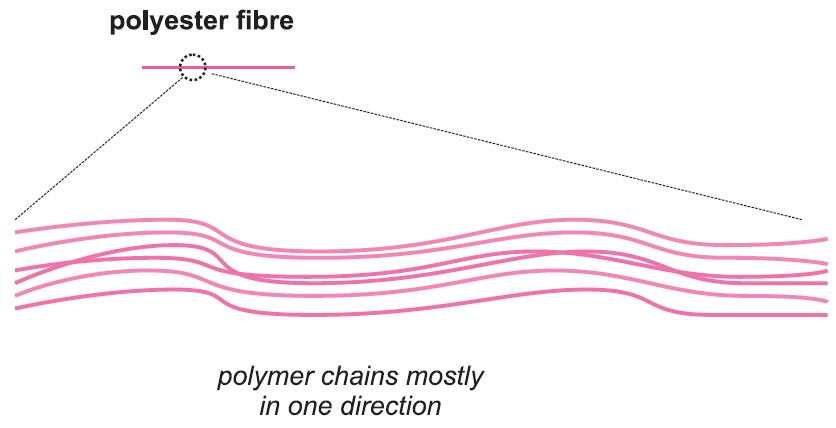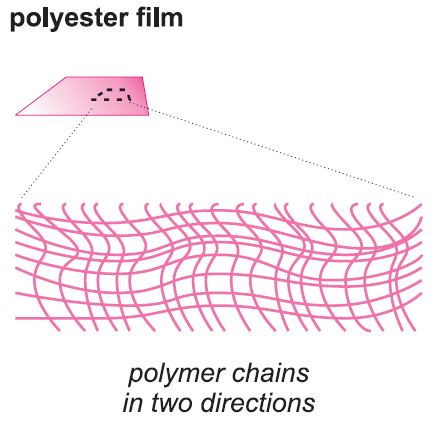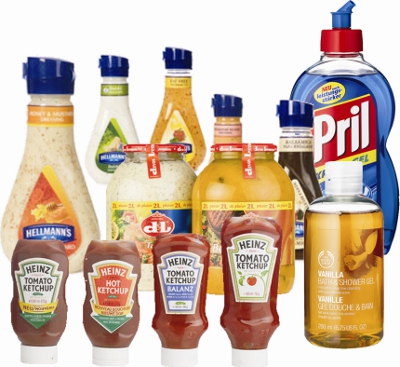
Uses of polyesters
Polyesters are extremely important polymers. Their most familiar applications are in clothing, food packaging and plastic water and carbonated soft drinks bottles.
The most used of the polyesters has the formula:
Being an ester, it is made from an acid, benzene-1,4-dicarboxylic acid (terephthalic acid), and an alcohol, ethane-1,2-diol.
It is often known by its trivial name, polyethylene terephthalate (PET).
The annual world wide production of PET is approximately 40 million tonnes and is growing at ca 7% per year. Of this, about 65% is used to make fibres, 5% for film and 30% for packaging.
Another useful polyester is produced from benzene-1,4-dicarboxylic acid and propane-1,3-diol (which replaces ethane-1,2-diol). It is known by its trivial name, polytrimethylene terephthalate.
The different uses of polyesters depend on their structure. The benzene rings in the molecular chain give them a rigid structure, leading to high melting points (over 500 K) and great strength. They do not discolour in light.
In PET fibres, the molecules are mainly arranged in one direction, in film, they are in two directions and for packaging, they are in three directions (Figure 1).
 |
 |
 |
Figure 1 Diagram to show the arrangement of PET molecules in PET fibres, films and packaging.
As fibres
The polyester is produced as small granules. These are melted and squeezed through fine holes and the resulting filaments spun to form a fibre. This fibre, commonly known as Terylene or Dacron, is widely used in clothing (for example, in suits, shirts and skirts) either alone or in blends with other manufactured or natural fibres, principally cotton.
It is also used for filling anoraks and bedding duvets to give good heat insulation. Other uses include car tyre cords, conveyor belts and hoses, where its strength and resistance to wear are paramount.
| Figure 2 Polyesters are often used to make the suits and parachutes for sky divers. By kind permission of Gayle Pook. |
 |
As films
The polyester can also be made into thin films which can be used in food packaging, audio and video tapes, electrical insulation, and X-ray films.
As packaging
A relatively newer use is for packaging, for example for bottles (see Figure 3). The small granules of the polyester are heated to about 500 K and further polymerization takes place. This heating is sometimes called solid-state polymerizing. The polymer is melted, moulded and then stretched. The molecules are now orientated in three directions giving the plastic great strength.
|
Figure 3 For beverage packaging the barrier properties of the PET to certain gases, the excellent mass to strength ratio and the recyclability of the final product are very important features influencing the choice of PET over other plastics or more traditional packaging materials. |
 |
Annual production of PET
| World | 53.3 million tonnes |
| Europe | 3.9 million tonnes |
| North America | 7.2 million tonnes |
| US | 7.0 million tonnes |
| FSU | 1.9 million tonnes |
| China | 18.9 million tonnes |
| Rest of Asia (Japan) |
16.4 million tonnes (1.5 million tonnes) |
Manufacture of PET
(a) The production of the monomer
Ethane-1,2-diol is reacted with benzene-1,4-dicarboxylic acid (sometimes known as terephthalic acid), or its dimethyl ester, in the presence of a catalyst, to produce initially the monomer and low molecular mass oligomers (containing up to about 5 monomer units).
Using the acid provides a direct esterification reaction, while the dimethyl ester reaction involves ester interchange. The dimethyl ester route requires the use of an acid catalyst whereas direct esterification is self-catalysed by the carboxylic acid groups.
The dimethyl ester route was originally preferred because the ester could be purified more readily than the acid. Very pure acid is now available in large commercial quantities; the modern processes therefore start from the acid.
(i) Starting from the acid: Direct Esterification Reaction
The acid reacts directly with ethane-1,2-diol:
(ii) Starting from the dimethyl ester: Ester Interchange Reaction
The acid reacts with methanol to form the dimethyl ester, with manganese(II) ethanoate being commonly used as the catalyst.
The dimethyl ester is then reacted with ethane-1,2-diol, by a process known as transesterification, in which one alcohol (ethane-1,2-diol) exchanges for another (methanol):
|
(b) Polymerization of the monomer
The monomer then undergoes polycondensation with the elimination of ethane-1,2-diol, a condensation reaction:

The polycondensation stage requires a catalyst, antimony(lll) oxide, and is carried out at high temperatures (535-575 K) when the monomer and polymer are molten. Low pressures are used to favour product formation. Ethane-1,2-diol is recycled.
Polyester production can be carried out using both batch and continuous processes. In the production of polyester fibre, the products of a continuous process can be fed directly into melt-spinning heads. This removes the casting, chipping, blending and drying stages that are necessary with batch processing.
Benzene-1,4-dicarboxylic acid
Benzene-1,4-dicarboxylic acid is manufactured by oxidation of 1,4-dimethylbenzene (commonly known as para-xylene).
One method is to pass air into the liquid hydrocarbon dissolved in ethanoic acid under pressure, in the presence of cobalt(ll) and manganese(ll) salts as catalysts, at about 500 K:
The pure acid used in PET production is obtained from the crude product by further processing to remove colour-forming impurities, and then by crystallization, washing and drying stages.
The manufacture of 1,4-dimethylbenzene (para-xylene) is described in the unit Benzene and methylbenzenes. A recent development is the production of bio-based 1,4-dimethylybenzene which means that bio-based polyesters can be manufactured.
Date last amended: 25th August 2016






